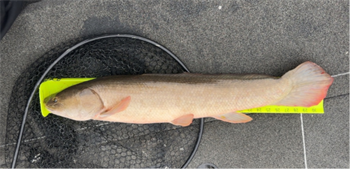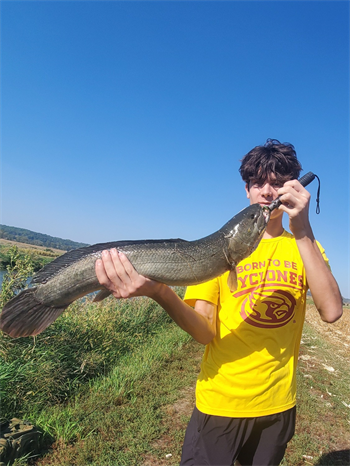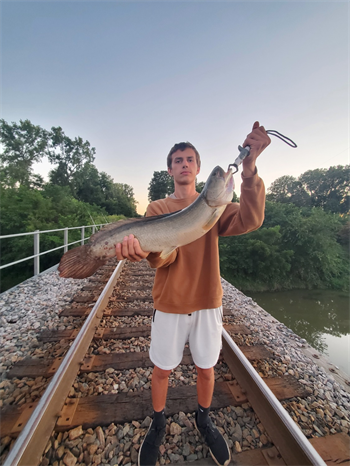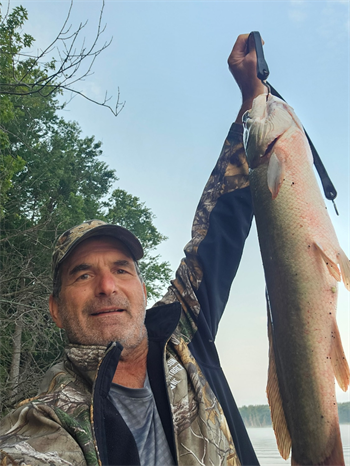Fish Iowa - Fish Species - Bowfin

Characteristics
Its body is dark olive above with lighter sides and cream-colored belly. The long dorsal fin is dark green with a narrow longitudinal olive-colored band near the top margin and another near the base. Males have a dark spot on the caudal fin, bordered with yellow or orange. Lower fins are green, vivid as fresh paint, during the breeding season. There are 66 to 68 scales in the lateral line. The dorsal fin has 47 to 51 soft rays and the anal fin has 9 or 10 rays. Its head is flattened on top and the mouth is large. Its teeth are sharp and strongly set in the jaws. Commonly reaches 6 to 8 pounds or more.
Foods
Crayfish, fish, frogs, large insects and leeches.
Expert Tip
The Bowfin, sometimes called a dogfish, is a voracious eater and can survive almost any environment - including being out of the water for days - since it can also breath air. It rivals the bullhead as Iowa's fish most able to handle tough conditions.
Details
The Bowfin, a primitive fish, is the sole representative of an ancient fish family. Although the body feels smooth and leathery, it is covered with cycloid scales, which are smooth and have no ctenii or rough prickles like some of the other fish.
Fossil remains of the ancestors of this fish are found in the rocks of Europe and the United States. The present day form is a voracious, hardy fish determined to live under any circumstances it may encounter. It prefers large, quiet waters and is abundant in the boundary rivers and overflow backwaters. As in the gars, the swim bladder serves as a lung, giving the Bowfin air breathing ability.
The ability to breathe air is early in life, and is used mostly at night and when water temperature is high, matching periods of greatest activity. The Bowfin can survive long air breathing periods. Young Bowfin can survive for 21 days in a pond with no standing water.
The Bowfin is found mainly in sloughs and ponds throughout the Mississippi River. It also lives in the southeast corner of Iowa in streams of the Lower Iowa and Lower Cedar River drainages. The Bowfin is rare in the interior streams and natural lakes of Iowa, but probably lives in the lower reaches of all the Mississippi River’s major tributaries.
The Bowfin lives in many aquatic habitats including: swamps, marshes, sloughs, oxbows, bayous, backwaters, borrow pits, ditches, streams and glacial lakes. In many of its habitats, like ditches and glacial lakes, it is most abundant in sections with thick beds of aquatic vegetation or other cover. Along the Mississippi and other large rivers, Bowfin are more often found in backwaters and oxbows choked with aquatic vegetation, than in the main channel. Bowfin prefer quiet, clear water, avoiding areas with strong current and high turbidity, yet are tolerant to silt, mud and high temperatures.
The Bowfin spawns in the spring, usually in May, in shallow quiet bays or backwaters of a river. It is a nest-builder and deposits the eggs in a saucer-like depression on the bottom or over sticks and vegetation. The males guard and tend to the eggs until they hatch. The young are herded about in schools until they are able to care for themselves. Bowfin reach 6- to 8-inches long at the end of the first growing season and often reach 2 feet or more at maturity.
The Bowfin is not commonly targeted by Iowa anglers, but as a predator it is caught regularly in areas where it lives. It is viewed as vulnerable according to the Iowa Wildlife Action Plan, but is not on the threatened or endangered species lists in Iowa (571 IAC 77.2(2) (2015)).
Recent stream sampling information is available from Iowa DNR's biological monitoring and assessment program.
Sources:
Harlan, J.R., E.B. Speaker, and J. Mayhew. 1987. Iowa fish and fishing. Iowa Conservation Commission, Des Moines, Iowa. 323pp.
Loan-Wilsey, A. K., C. L. Pierce, K. L. Kane, P. D. Brown and R. L. McNeely. 2005. The Iowa Aquatic Gap Analysis Project Final Report. Iowa Cooperative Fish and Wildlife Research Unit, Iowa State University, Ames.
Illustration by Maynard Reece, from Iowa Fish and Fishing.
Distribution Map
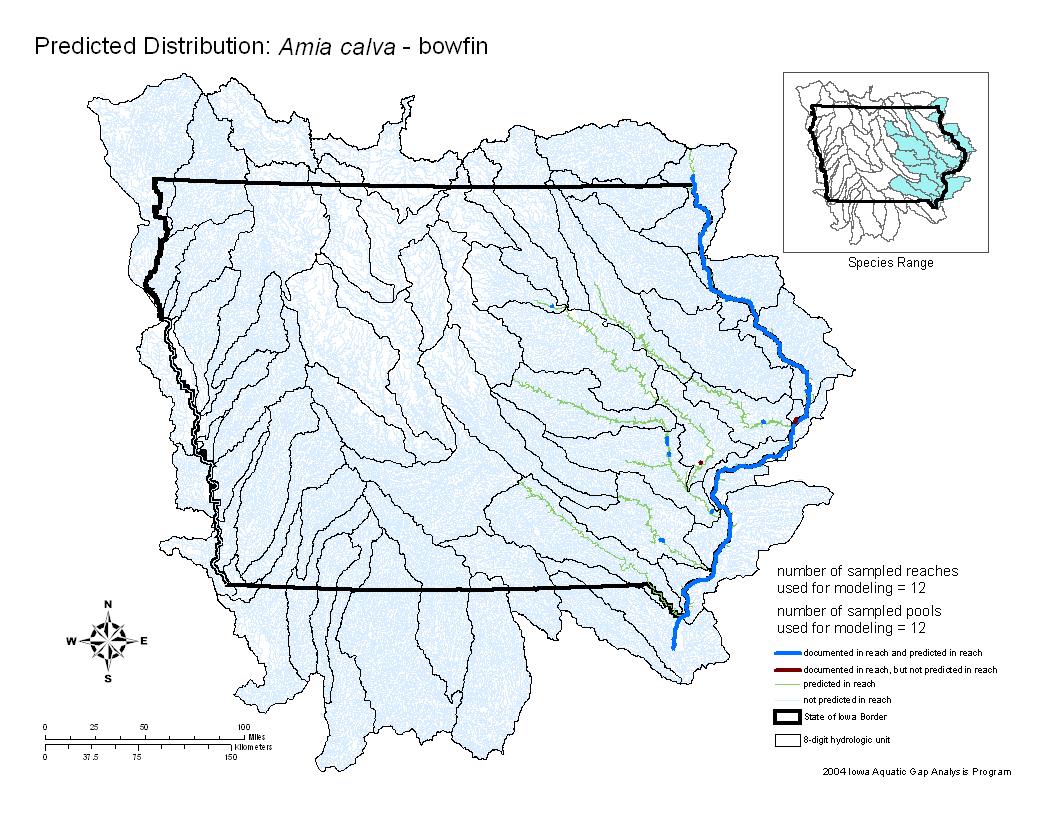
With the exception of rare fish collected in Spirit and Okoboji Lakes, the Bowfin is found mostly in sloughs and ponds of the Mississippi River. It has been seen in collections in the lower reaches of the Iowa-Cedar Rivers drainage and is probably in the lower reaches of all the major Mississippi River tributaries. This fish is extremely rare in Iowa's interior waters.
See our most recent distribution data for this species on the Iowa DNR's Bionet application.
State Record(s)
Master Angler Catches
Fish Surveys
Tip: Click Species Length by Site, then use the dropdown to filter by fish species of interest.Where this Fish Is Found
Big Lake (Lansing)
Big Timber Complex
Bussey Lake
Cedar River (Cedar Rapids to Moscow)
Cedar River (La Porte City to Cedar Rapids)
Iowa River (Coralville Lake to River Junction)
Norwegian Lake
Pool 16, Mississippi River
Pool 17, Mississippi River
Pool 18, Mississippi River
Pool 19, Mississippi River

